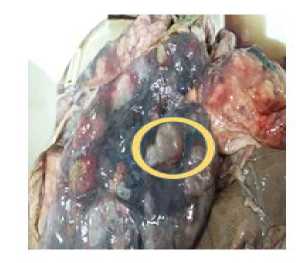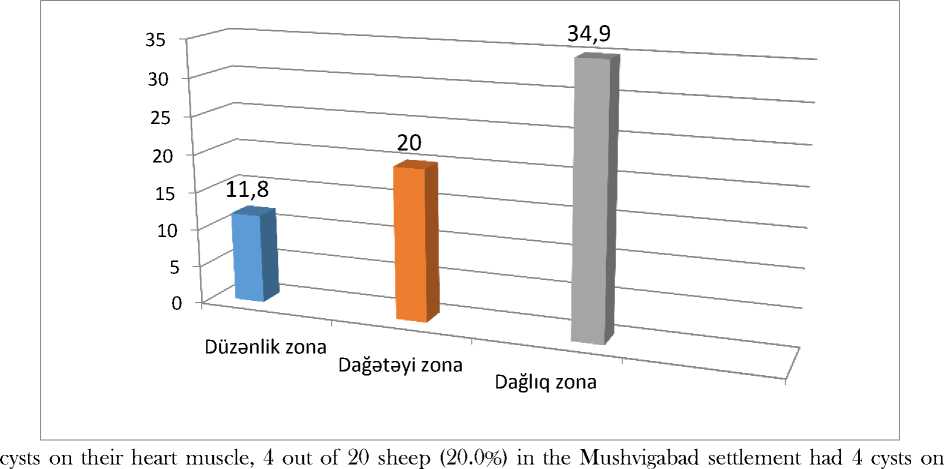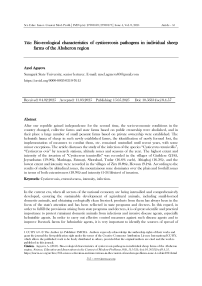Bio-ecological characteristics of cysticercosis pathogens in individual sheep farms of the Absheron region
Автор: Agayeva A.
Журнал: Science, Education and Innovations in the Context of Modern Problems @imcra
Статья в выпуске: 4 vol.8, 2025 года.
Бесплатный доступ
After our republic gained independence for the second time, the socio-economic conditions in the country changed, collective farms and state farms based on public ownership were abolished, and in their place a large number of small peasant farms based on private ownership were established. The helminth fauna of sheep in such newly established farms, the identification of newly formed foci, the implementation of measures to combat them, etc. remained unstudied until recent years, with some minor exceptions. The article discusses the study of the infection of the species “Cysticercus tenuicollis”, “Cysticercus ovis” by research stations, altitude zones and seasons of the year. The highest extent and intensity of the invasion of “Cysticercus tenuicollis” was recorded in the villages of Gizildere (21%), Jeyranbatan (19.0%), Mashtaga, Fatmayi, Shorabad, Tudar (16.6% each), Altiaghaj (16.3%), and the lowest extent and intensity were recorded in the villages of Zira (8.8%), Hovsan (9.1%). According to the results of studies by altitudinal zones, the mountainous zone dominates over the plain and foothill zones in terms of both extensiveness (18.9%) and intensity (1-34 blisters) of invasion.
Cysticercosis, extensiveness, intensity, infection
Короткий адрес: https://sciup.org/16010616
IDR: 16010616 | DOI: 10.56334/sei/8.4.55
Текст научной статьи Bio-ecological characteristics of cysticercosis pathogens in individual sheep farms of the Absheron region
In the current era, when all sectors of the national economy are being intensified and comprehensively developed, ensuring the sustainable development of agricultural animals, including small-horned domestic animals, and obtaining ecologically clean livestock products from them has always been in the focus of the state's attention and has been reflected in state programs and decrees. In this regard, in order to fulfill the provisions arising from state programs and decrees, it is of great scientific and practical importance to protect ruminant domestic animals from infectious and invasive disease agents, especially helminthic agents. In order to carry out effective control measures against such disease agents and to improve livestock farms for helminthic agents, it is very important to identify the sources of spread of these helminthic agents in nature and in livestock farms and the causes of their spread.
As is known, after our country gained independence for the second time, the socio-economic conditions in the country changed, collective farms and state farms based on public ownership were abolished, and in their place a large number of small peasant farms based on private ownership were established. Such farms, along with a number of advantages, also have some shortcomings. Thus, unlike previous years, many of such farms do not have qualified personnel potential (veterinarians, zootechnicians, etc.), and timely measures are not taken to combat pests and diseases, especially helminth pathogens. Due to some difficulties of the transition period, various problems have arisen in the irrigation system, pastures and other areas. In recent years, in large cities and settlements, in many cases, slaughterhouses and meat sales points have been operating in conditions that do not meet veterinary and sanitary requirements. All this has led to the spread and increase in the number of various helminth pathogens in the territories of private and farm farms. The helminth fauna of ruminant animals in such newly established farms, the identification of newly formed foci, the implementation of measures to combat them, etc., have remained unstudied until recent years, with some minor exceptions. The article discusses the study of the infection of the species "Cysticercus tenuicollis", "Cysticercus ovis", which are the causative agents of these helminthiasis, by research sites, altitude zones and seasons of the year.
Subfamily: Taeniata Skrjabin et Shulz, 1937
Family: Taeniidae Lülwig, 1886
Genus: Taenia Linnaens, 1758
Species: Cysticercus tenuicollis = Taenia hydatigena Pallas, 1766
Final host - domestic and wild predators; intermediate host - domestic and wild cloven-hoofed animals, humans. Localization: in final hosts - the small intestine; in intermediate hosts - the peritoneum, pleura, in rare cases it parasitizes in other organs - the lungs, the mucous membrane of the esophagus, the spleen, the bladder, the diaphragm, the gallbladder, the bile ducts, the fetus, the ovaries. Distribution: widespread everywhere ( Алибеков : 2011, p. 377-381).
Tenuikol cysticercosis of sheep is a widespread larval cysticercosis. It causes significant economic losses, damage to organs and even the whole body. In the migratory stage of development, the parasite causes changes in the leukogram, lowers hemoglobin, reduces the amount of vitamins A and C in the blood and tissues, and in 2-2.5-month-old lambs, it also causes death (Tkhakakhova et al. 2015, pp. 436439).
Species: Cysticercus ovis (=Taenia ovis (Cobbold, 1869) Ransom, 1913)
Final host - domestic and wild canids; intermediate host - sheep, goats, gazelles, camels, sometimes humans. Localization: in final hosts - small intestine; in intermediate hosts, cysticerci are in the heart, liver, under the mucous membrane of the stomach. Distribution: very widespread species.
Material and methodology
In order to study the distribution of the main helminthic pathogens of sheep in various landscape-ecological zones in the Absheron Peninsula and the adjacent Khizi district, short-term trips and expeditions were organized to the research areas during 2015-2019. For this purpose, the location and pasture areas of private farms engaged in sheep breeding in various areas of the region, the number of sheep, etc. were determined, conversations were held with the entrepreneurs to conduct research on those farms and their consent was obtained. Full helminthological examinations were conducted on samples collected from those farms.

The initial processing of the materials was carried out at the slaughterhouses, and the final processing was carried out in the Parasitology Laboratory of the Ministry of Agriculture's
Veterinary and Animal Health Department (Figure 1).
Figure 1. Collection of blisters
In addition, studies were conducted at slaughterhouses for sale in the study areas, including sacrificial sheep slaughterhouses in shrines, and consent was obtained for this purpose. The internal organs of the slaughtered sheep (with the place of delivery determined) were examined by visual observations and complete dissection methods, and helminthological materials were collected. The collected helminthological materials were stored in 70% alcohol solution and analyzed in terms of fauna.
In order to determine the distribution, specificity, and pathogenicity of the detected helminthic pathogens in organs and tissues, the intensity and extensiveness of the invasion were accurately calculated and the results obtained were statistically analyzed (Methods of veterinary clinical laboratory diagnostics, 2004, p. 502).
In order to study the distribution of the main helminthic agents among sheep depending on the altitudinal zones and seasons of the year, research was conducted in several characteristic landscape ecological zones - in the Absheron region - in the semi-desert landscape of the lowlands and intermountain plains at an altitude of 28-100m, in the steppe and partly forest-steppe landscape of the lowlands at an altitude of 101-150-1000m, and in the broad-leaved forest and post-forest meadow-shrub landscape of the middle mountains at an altitude of 1200-1800-2200m. The distribution of the detected helminthic agents was also analyzed according to the seasons of the year.
Conclusion
The distribution of the species “Cysticercus tenuicollis” was studied in various villages and settlements of the Absheron region at research sites. The results of the study are given in Table 1.
Table 1
Distribution of the species “Cycticercus tenuicollis” in the Absheron region by research sites (according to the complete helminthological survey)
|
Research stations |
Researche d (number of people) |
Infected (head count) |
Extensiveness of invasion (in %) |
Intensity of invasion (number of bubbles) |
|
Cumin |
79 |
7 |
8.8 |
3-14 |
|
Hovsan |
55 |
5 |
9.1 |
2-7 |
|
Mashtaga |
42 |
7 |
16.6 |
5-11 |
|
Mammadli |
29 |
5 |
17.2 |
3-7 |
|
Fatmay |
48 |
8 |
16.6 |
5-11 |
|
Novkhani |
84 |
11 |
13.1 |
2-24 |
|
Mehdiabad |
20 |
2 |
10.0 |
2-5 |
|
Khyrdalan |
17 |
3 |
17.6 |
5-10 |
|
Jeyranbatan |
21 |
4 |
19.0 |
2-23 |
|
Z. Taghiyev |
69 |
8 |
11.6 |
1-10 |
|
New Life |
29 |
3 |
10.3 |
4-7 |
|
Gobu |
36 |
5 |
13.9 |
1-9 |
|
Sulutape |
33 |
4 |
12.1 |
3-10 |
|
Guzdek |
24 |
3 |
12.5 |
1-12 |
|
Shorabad |
12 |
2 |
16.6 |
2-3 |
|
Mushvigabad |
20 |
4 |
13.8 |
3-8 |
|
Six-tree |
43 |
7 |
16.3 |
1-34 |
|
Golden Valley |
62 |
13 |
21.0 |
1-15 |
|
Tudor |
48 |
6 |
12.5 |
3-32 |
|
Total: |
771 |
108 |
14.0 |
1-34 |
As can be seen from the table, the highest extent and intensity of the invasion of "Cysticercus tenuicollis" was recorded in the villages of Gizildara (21%), Jeyranbatan (19.0%), Mashtaga, Fatmayi, Shorabad, Tudar (16.6% each), Altiaghaj (16.3%), and the lowest extent and intensity was recorded in Zira (8.8%), Hovsan (9.1%).
During the study, the distribution of the species “Cysticercus tenuicollis” among sheep was studied by altitudinal zones. The results of the study are given in Table 2.
Table 2
Distribution of the species “Cysticercus tenuicollis” in the Absheron region by altitudinal zones (according to a complete helminthological survey).
|
Ecological zones |
Researched (number of heads) |
Infected |
IE, in % |
II (number of bubbles) |
|
Plain zone |
303 |
30 |
9.9 |
2-23 |
|
Foothills zone |
315 |
49 |
15.5 |
1-24 |
|
Mountainous zone |
153 |
29 |
18.9 |
1-34 |
|
Total: |
771 |
108 |
14.0 |
1-34 |
As can be seen from the table, the mountainous zone prevails over the plain and foothill zones in terms of both the extensiveness (18.9%) and intensity (1-34 cysts) of the invasion of the species “Cysticercus tenuicollis”. In our opinion, this is due to the large number of farms engaged in sheep breeding in the mountainous zone, as well as the large number of shepherd dogs, which are the last owners of the species “Cysticercus tenuicollis” in those farms. In addition, the number of wild canids (jackals, wolves, foxes) is also high in the mountainous zone. Thus, domestic and wild canids infected with cysticercosis pathogens regularly spread the eggs of the invading agent to farms and pastures, which leads to infection of sheep (Fataliyev: 2016, p. 46).
During the study, the incidence of sheep infected with teniiasis pathogens by season was investigated. The results of the study are given in Table 3.
Table 3
Infection of sheep with “Cysticercus. Tenuicollis” by season (according to complete helminthological analysis)
|
Of t year seasons |
Researched (number heads) |
Infected |
IE, in % |
II (number of bubbles) |
|
Summer |
172 |
21 |
12.2 |
3-14 |
|
Summer |
163 |
28 |
17.2 |
2-24 |
|
Autumn |
244 |
34 |
13.9 |
1-12 |
|
Winter |
192 |
25 |
13.0 |
1-10 |
|
Total: |
771 |
108 |
14.0 |
1-34 |
As can be seen from the table, a high percentage of sheep infection with “Cysticercus tenuicollis” was observed in summer (17.2%) and autumn (13.9%), while relatively low infection was observed in spring (12.2%) and winter (13.0%). The high intensity of invasion coincides with summer (2-24 cysts) and spring (3-14 cysts), and relatively low indicators are observed in autumn and winter (1-12 and 1-10 cysts). The total infection of sheep with C. tenuicollis in the study areas was 14.0%.
Infection of sheep with cysticercosis depends on the seasons of the year as well as the sanitary condition of farms and pastures. Also, dogs infected with teniiasis on farms play an important role in the infection of sheep.
The species "Cysticercus. tenuicollis" has an epizootological role for adult ungulates and predators, and an epidemiological role for humans.
Later, research was conducted to study the distribution of the Cysticercus ovis species in both vertical and horizontal directions in the Absheron region. During the study, 2 out of 79 sheep (2.5%) examined by us in the Zira village area had 1 cyst each in the heart and liver, 2 out of 55 sheep (3.6%) in the Hovsan village area had 3-7 cysts on the liver and 2-5 cysts on the heart muscle, 2 out of 42 sheep (4.8%) in the Mashtaga village area had 2 cysts on the heart muscle and 5 cysts on the liver, 2 out of 29
sheep (6.9%) in the Mammadli village area had 3 cysts on the heart muscle, 2 out of 84 sheep (2.4%) in the Novkhani village area had 1 cyst each in the liver and heart, 2 out of 17 sheep (11.8%) in the Khirdalan city area had 4 cysts on the liver and 2 cysts on the heart muscle, 4 out of 21 sheep in the Jeyranbatan settlement area had (19.0%) had 3-8 cysts on their livers and 6 cysts on their heart muscle, 9 out of 69 sheep (13.0%) in the Z. Taghiyev settlement had 1-2 cysts on their livers and 2-3 cysts on their heart muscle, 8 out of 29 sheep (27.6%) in the Yeni Yashma settlement had 3 cysts on their livers and 48 cysts on their heart muscle, 2 out of 36 sheep (5.5%) in the Gobu settlement had 3 cysts on their livers, 4 out of 24 sheep (16.7%) in the Guzdek settlement had 2-3 cysts on their livers and 2 cysts on their heart muscle, 4 out of 12 sheep (33.3%) in the Shorabad settlement had 3-7 cysts on their livers and 4

their livers and 4 cysts on their heart 2-4 cysts were found in the muscle, 4-17 in the heart muscle and 2-
13 in the liver of 15 out of 43 sheep (34.9%) in the village of Altia g aj, 2-13 in the liver of 21 out of 62 sheep (33.9%) in the village of Gizildara, 3-11 in the heart muscle, and 1-10 in the liver and 3-14 in the heart muscle of 16 out of 48 sheep (33.3%) in the village of Tudar. No infection with “Cysticercus ovis” was found among the sheep examined in the village of Fatmayi, Mehdiabad and Sulutepe settlements. Thus, the highest infection rates were detected in the villages of Altiagach (34.9%), Gizildara (33.9%), Tudar (33.3%) and Shorabad settlement (33.3%), while the lowest infection rates were detected in the villages of Novkhani (2.4%), Zira (2.5%) and Hovsan (3.6%).
As can be seen from the results of the study, “Cysticercus. ovis” is unevenly distributed in the study areas. Thus, the infection rate of this species in the study areas included in the plain zone (in the villages of Hovsan, Mashtaga, Mammadli, etc.) is relatively low (2.5% - up to 11.8%), in the areas included in the foothill zone it is slightly higher (11.8% - up to 20.0%), and in the mountainous zone it is even higher (20.0% - up to 34.9%). This can be clearly seen from the histogram below (histogram 1).
Histogram 1. Distribution of the species “Cysticercus. ovis” by altitudinal zones
As is known, sheep in the villages and settlements of the Absheron region are mainly kept in private farms and their number is relatively small, in such farms the number of domestic dogs, which are the final hosts of the “Cysticercus ovis” species, is usually small - 1-2 cysts, but in the foothills and mountainous zones the number of sheep herds increases as they move up towards the mountainous zones, the number of dogs on farms increases, and at the same time, in some farms the dogs are not dewormed. In addition, it should be noted that as you move up from the foothills to the mountainous areas, the number of wild canids - wolves, jackals, foxes, which are the final hosts of the “Cysticercus. ovis” species, also increases. It is for these reasons that the percentage of infection in those areas is high.
“Cysticercus ovis” Analysis of the distribution of the species across organs shows that the cysticerci of the species are quite widespread in both the liver and heart muscles, causing a decrease in their normal vital activity and productivity (Klesov: 2011, pp. 93-107).


